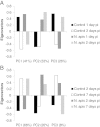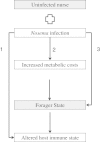Chronic parasitization by Nosema microsporidia causes global expression changes in core nutritional, metabolic and behavioral pathways in honey bee workers (Apis mellifera)
- PMID: 24245482
- PMCID: PMC4046765
- DOI: 10.1186/1471-2164-14-799
Chronic parasitization by Nosema microsporidia causes global expression changes in core nutritional, metabolic and behavioral pathways in honey bee workers (Apis mellifera)
Abstract
Background: Chronic infections can profoundly affect the physiology, behavior, fitness and longevity of individuals, and may alter the organization and demography of social groups. Nosema apis and Nosema ceranae are two microsporidian parasites which chronically infect the digestive tract of honey bees (Apis mellifera). These parasites, in addition to other stressors, have been linked to increased mortality of individual workers and colony losses in this key pollinator species. Physiologically, Nosema infection damages midgut tissue, is energetically expensive and alters expression of immune genes in worker honey bees. Infection also accelerates worker transition from nursing to foraging behavior (termed behavioral maturation). Here, using microarrays, we characterized global gene expression patterns in adult worker honey bee midgut and fat body tissue in response to Nosema infection.
Results: Our results indicate that N. apis infection in young workers (1 and 2 days old) disrupts midgut development. At 2 and 7 days post-infection in the fat body tissue, N. apis drives metabolic changes consistent with energetic costs of infection. A final experiment characterizing gene expression in the fat bodies of 14 day old workers parasitized with N. apis and N. ceranae demonstrated that Nosema co-infection specifically alters conserved nutritional, metabolic and hormonal pathways, including the insulin signaling pathway, which is also linked to behavioral maturation in workers. Interestingly, in all experiments, Nosema infection did not appear to significantly regulate overall expression of canonical immune response genes, but infection did alter expression of acute immune response genes identified in a previous study. Comparative analyses suggest that changes in nutritional/metabolic processes precede changes in behavioral maturation and immune processes.
Conclusions: These genome-wide studies of expression patterns can help us disentangle the direct and indirect effects of chronic infection, and understand the molecular pathways that regulate disease symptoms.
Figures


Similar articles
-
Silencing the Honey Bee (Apis mellifera) Naked Cuticle Gene (nkd) Improves Host Immune Function and Reduces Nosema ceranae Infections.Appl Environ Microbiol. 2016 Oct 27;82(22):6779-6787. doi: 10.1128/AEM.02105-16. Print 2016 Nov 15. Appl Environ Microbiol. 2016. PMID: 27613683 Free PMC article.
-
Impact of Nosema ceranae and Nosema apis on individual worker bees of the two host species (Apis cerana and Apis mellifera) and regulation of host immune response.J Insect Physiol. 2018 Feb-Mar;105:1-8. doi: 10.1016/j.jinsphys.2017.12.010. Epub 2017 Dec 29. J Insect Physiol. 2018. PMID: 29289505
-
Chronic Nosema ceranae infection inflicts comprehensive and persistent immunosuppression and accelerated lipid loss in host Apis mellifera honey bees.Int J Parasitol. 2018 May;48(6):433-444. doi: 10.1016/j.ijpara.2017.11.004. Epub 2018 Feb 13. Int J Parasitol. 2018. PMID: 29452081
-
Effects of the gut parasite Nosema ceranae on honey bee physiology and behavior.Curr Opin Insect Sci. 2018 Apr;26:149-154. doi: 10.1016/j.cois.2018.02.017. Epub 2018 Mar 2. Curr Opin Insect Sci. 2018. PMID: 29764655 Review.
-
Nosema ceranae in European honey bees (Apis mellifera).J Invertebr Pathol. 2010 Jan;103 Suppl 1:S73-9. doi: 10.1016/j.jip.2009.06.017. Epub 2009 Nov 11. J Invertebr Pathol. 2010. PMID: 19909977 Review.
Cited by
-
Age and Method of Inoculation Influence the Infection of Worker Honey Bees (Apis mellifera) by Nosema ceranae.Insects. 2019 Nov 22;10(12):417. doi: 10.3390/insects10120417. Insects. 2019. PMID: 31766667 Free PMC article.
-
Robust Transcriptional Response to Heat Shock Impacting Diverse Cellular Processes despite Lack of Heat Shock Factor in Microsporidia.mSphere. 2019 May 22;4(3):e00219-19. doi: 10.1128/mSphere.00219-19. mSphere. 2019. PMID: 31118302 Free PMC article.
-
Vairimorpha (Nosema) ceranae Infection Alters Honey Bee Microbiota Composition and Sustains the Survival of Adult Honey Bees.Biology (Basel). 2021 Sep 13;10(9):905. doi: 10.3390/biology10090905. Biology (Basel). 2021. PMID: 34571782 Free PMC article.
-
Nosema Tolerant Honeybees (Apis mellifera) Escape Parasitic Manipulation of Apoptosis.PLoS One. 2015 Oct 7;10(10):e0140174. doi: 10.1371/journal.pone.0140174. eCollection 2015. PLoS One. 2015. PMID: 26445372 Free PMC article.
-
Effects on Some Therapeutical, Biochemical, and Immunological Parameters of Honey Bee (Apis mellifera) Exposed to Probiotic Treatments, in Field and Laboratory Conditions.Insects. 2020 Sep 17;11(9):638. doi: 10.3390/insects11090638. Insects. 2020. PMID: 32957451 Free PMC article.
References
Publication types
MeSH terms
Substances
LinkOut - more resources
Full Text Sources
Other Literature Sources

